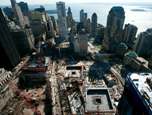 Few New Yorkers noticed earlier this summer when a dozen police horses boarded in a stable located in lower Manhattan for most of the 20th century were loaded into trailers and moved uptown.
Few New Yorkers noticed earlier this summer when a dozen police horses boarded in a stable located in lower Manhattan for most of the 20th century were loaded into trailers and moved uptown.
The New York Police Department relocated the horses – a quaint curiosity to neighbors living in high-end Tribeca lofts and townhouses – to build a temporary staging area for 220 officers newly assigned to protect ground zero.
The lower Manhattan force will eventually rise to 670 – larger than any of the 76 precincts in the five boroughs and entire departments across the country. The multiple thousands who will visit the Sept. 11 memorial after it opens this fall will endure airport-style screening and be watched by hundreds of closed-circuit cameras as part of the attack site opens publicly for the first time since 2001.
Securing the World Trade Center site from terror attacks has been one of law enforcement’s most pressing problems long before the al-Qaida attack that destroyed the towers. In 1993, Islamic extremists exploded a rented van rigged with fertilizer bomb in a trade center parking garage, killing six people and injuring more than 1,000 others. And in 2006, authorities alleged a Lebanese man loyal to Osama bin Laden plotted to flood ground zero and the rest of lower Manhattan by exploding backpacks in commuter train tunnels under the Hudson River.
While New York leaders call the resurrection of the 16-acre property may be viewed by most Americans as a triumph of the nation’s resolve, law enforcement believe terrorists see it as another chance to prove their tenacity.
“Without question it is a target, because it has tremendous symbolism,” said James Kallstrom, a former top FBI official who headed the New York City office in the 1990s. “Going back and attacking a landmark that was already attacked once is the ultimate challenge.”
The site isn’t the target of a current known plot, but it “remains squarely in the terrorists’ crosshairs,” says Police Commissioner Raymond Kelly.
Fears of a repeated plot against the site years ago moved its signature skyscraper several feet from its original spot.
An original plan putting 1 World Trade Center 25 feet off a state highway near the Hudson River raised concerns by the NYPD that it could be vulnerable to car or truck bombs. A redesign moved it farther off the street and incorporated a windowless 200-foot base.
To make the base of the 1,776-foot tower less bunker-like, the new plan called for a facade of 2,000 glass panels attached to aluminum screens. But tests showed that the glass failed to shatter into harmless bits as hoped and the Port Authority, which owns the site, had to send architects back to the drawing board.
Developers and law enforcement also have grappled with how to best police the anticipated steady flow of tourists, workers and commerce at the site without turning it into an inhospitable, armed camp.
Kallstrom, while the top counterterrorism adviser to former Gov. Gov. George Pataki in the mid-2000s, was an architect of an ambitious security plan for 1 World Trade Center – scheduled to be finished in 2013 or early 2014 – the National September 11 Memorial & Museum and other office towers and transit at the site.
The measures – combining architectural innovation, high-tech gadgetry and good old-fashioned manpower provided by the NYPD, the Port Authority of New York and New Jersey police and private security firms – will make it “a very, very secure site,” Kallstrom said.
Police plan to use a vehicle security center to screen tour buses, trucks and cars before they enter the site and park or makes deliveries using an underground roadway. Pedestrian traffic, including visitors to the museum, also will be screened before they can enter the central plaza.
Ticketed visitors to the memorial will be funneled into a security screening room with airport-style metal detectors and X-ray machines. Employees and frequent visitors will be pre-screened so they can bypass regular checkpoints.
The security plan also calls for 400 closed-circuit surveillance cameras in and around the trade center site. Live feeds will be monitored around the clock at an NYPD command center located in a private office building near Wall Street. A computer system there uses “video analytic” computer software designed to detect potential threats like unattended bags, and retrieve stored images based on descriptions of terror or other criminal suspects.
Final touches are also being put on another ambitious piece of the plan: Screening every car, truck and other vehicle for radioactive materials – evidence of a possible dirty bomb – and other potential threats as they enter lower Manhattan. To achieve that, police are installing cameras, radiation detectors and license-plate readers at the 16 bridges and four tunnels going in and out of Manhattan.
The 220 police officers will start patrolling the site and immediate surroundings by the end of the month, in time for the memorial’s opening on Sept. 11. Many of the officers have volunteered to undergo special counterterror training, including how to spot suspects doing reconnaissance at the site. They’re also being drilled on use of heavy weapons and emergency medical response.
Port Authority of New York and New Jersey police officers are also on the site; the agency wouldn’t disclose how many for security reasons.
The NYPD plans to add more officers as the site gets built out; up to four more office towers and a transit hub are also planned. The department hopes to have a precinct office at the site or very near it one day.
“As the location is built out down there, as buildings go up and it’s populated, then we will increase the number of police officers down there,” Kelly said.
And eventually, the horse stable located 12 blocks north of ground zero will return as it was when police officers get a permanent home, said Julie Menin, who heads the downtown community board of the neighborhood that includes the site.
Whether the extra security will help restore the sense of calm shattered by Sept. 11 is another question.
“On the one hand, it can make people feel much safer,” Menin said. “But it can alarm people as well.”
{OANow.com/Matzav.com Newscenter}











